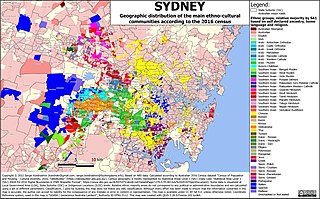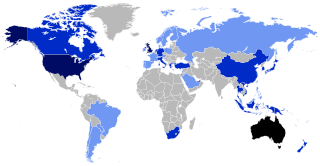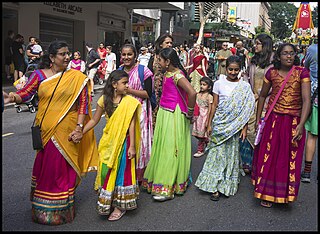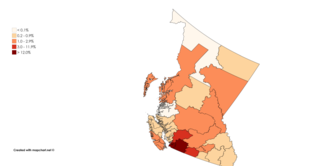
The demographic characteristics of the population of Fiji are known through censuses, usually conducted in ten-year intervals, and has been analysed by statistical bureaus since the 1880s. The Fijian Bureau of Statistics (FBOS) has performed this task since 1996, the first enumerated Fiji census when an independent country. The 2017 census found that the permanent population of Fiji was 884,887, compared to 837,271 in the 2007 census. The population density at the time in 2007 was 45.8 inhabitants per square kilometre, and the overall life expectancy in Fiji was 67 years. Since the 1930s the population of Fiji has increased at a rate of 1.1% per year. Since the 1950s, Fiji's birth rate has continuously exceeded its death rate. The population is dominated by the 15–64 age segment. The median age of the population was 27.9, and the gender ratio of the total population was 1.03 males per 1 female.

The population of Australia is estimated to be 27,135,100 as of 11 April 2024. Australia is the 56th most populous country in the world and the most populous Oceanian country. Its population is concentrated mainly in urban areas, particularly on the Eastern, South Eastern and Southern seaboards, and is expected to exceed 30 million by 2029.
The terms multiracial people or mixed-race people refer to people who are of more than one race and the terms multi-ethnic people or ethnically mixed people refer to people who are of more than one ethnicity. A variety of terms have been used both historically and presently for mixed-race people in a variety of contexts, including multiethnic, polyethnic, occasionally bi-ethnic, Métis, Muwallad, Coloured, Dougla, half-caste, ʻafakasi, mestizo, mutt, Melungeon, quadroon, octoroon, sambo/zambo, Eurasian, hapa, hāfu, Garifuna, pardo, and Gurans. A number of these terms are now considered offensive, in addition to those that were initially coined for pejorative use. "Melezi" are called the offspring of Muslim Romani men and woman of host populations.
Anglo-Celtic Australians is an ancestral grouping of Australians whose ancestors originate wholly or partially in the British Isles - predominantly in England, Ireland, Scotland and Wales, as well as the Isle of Man and Channel Islands.

South Asian Canadians are Canadians who were either born in or can trace their ancestry to the Indian subcontinent, which includes the nations of India, Pakistan, Bangladesh, Nepal, Sri Lanka, Bhutan, and the Maldives.

Nadroga-Navosa is one of the fourteen provinces of Fiji and one of eight based in Viti Levu, Fiji's largest island. It is about 2,385 square kilometers and occupies the South-West and Central areas of Viti Levu, Fiji's principal island. The province includes the Mamanuca Archipelago,Malolo Islands, off the west coast of Viti Levu, Vatulele, as well as the remote Conway Reef in the southwest. The population at the 2017 census was 58,931, being the fifth largest province. The main town in Nadroga-Navosa is Sigatoka, with a population of 9622.

Sydney is Australia's most populous city, and is also the most populous city in Oceania. In the 2021 census, 5,231,147 persons declared themselves as residents of the Sydney Statistical Division–about one-fifth (20.58%) of Australia's total population. With a population density of 2037 people per square kilometre, the urban core has population density five times that of the greater region.
Malaysian Australians refers to Malaysians who have migrated to Australia or Australian-born citizens who are of Malaysian descent. This may include Malaysian Chinese, Malays, Malaysian Indians, Orang Asal, mixed Malaysians and other groups.

Australians, colloquially known as Aussies, are the citizens, nationals and individuals associated with the country of Australia. This connection may be residential, legal, historical or ethno-cultural. For most Australians, several of these connections exist and are collectively the source of their being Australian. Australian law does not provide for a racial or ethnic component of nationality, instead relying on citizenship as a legal status.

Indian Australians or Indo-Australians are Australians of Indian ancestry. This includes both those who are Australian by birth, and those born in India or elsewhere in the Indian diaspora. Indian Australians are one of the largest groups within the Indian diaspora, with 783,958 persons declaring Indian ancestry at the 2021 census, representing 3.1% of the Australian population. In 2019, the Australian Bureau of Statistics estimated that 721,050 Australian residents were born in India.

South African Australians are citizens or residents of Australia who are of South African descent.

Indo-Canadians or Indian Canadians, are Canadians who have ancestry from India. The term East Indian is sometimes used to avoid confusion with the Indigenous peoples of Canada. Categorically, Indo-Canadians comprise a subgroup of South Asian Canadians which is a further subgroup of Asian Canadians. According to Statistics Canada, Indians are one of the fastest growing communities in Canada and one of the largest non-European ethnic groups.

Melbourne is Australia's largest city and has a diverse and multicultural population.
Indo-Fijians, also known as Indian Fijians, are Fijian citizens of Indian descent, and include people who trace their ancestry to various regions of India and the Indian subcontinent. Although Indo-Fijians constituted a majority of Fiji's population from 1956 through the late 1980s, discrimination and the resulting brain drain resulted in them numbering 313,798 (37.6%) out of a total of 827,900 people living in Fiji as of 2007.
European Australians are citizens or residents of Australia whose ancestry originates from the peoples of Europe. They form the largest panethnic group in the country. At the 2021 census, the number of ancestry responses categorised within European ancestral groups as a proportion of the total population amounted to more than 57.2%. It is impossible to quantify the precise proportion of the population with European ancestry. For instance, many census recipients nominated two European ancestries, tending towards an overcount. Conversely, 29.9% of census recipients nominated "Australian" ancestry, tending towards an undercount.

Overseas Indians, officially Non-Resident Indians (NRIs) and People of Indian Origin (PIOs) are Indians who reside or originate outside of India. According to the Government of India, Non-Resident Indians are citizens of India who currently are not living in India, while the term People of Indian Origin refers to people of Indian birth or ancestry who are citizens of countries other than India. Overseas Citizenship of India (OCI) is given to People of Indian Origin and to persons who are not People of Indian Origin but married to People of Indian Origin. Persons with OCI status are known as Overseas Citizens of India (OCIs). The OCI status is a permanent visa for visiting India with a foreign passport.

Tevita Kuridrani is a Fijian-born Australian rugby union player. His usual position is outside-centre. He is currently with French club Biarritz and previously played for the Brumbies and Western Force in Super Rugby. Kuridrani has sixty caps for Australia in international rugby.
Tongan Australians are Australians who are of ethnic Tongan descent or Tongans who hold Australian citizenship.

Kirisi Kuridrani, formerly Kirisi Nasiganiyavi, is an Australian rugby union player of Fijian descent. He is currently signed to Japanese club Honda Heat and previously played for the Queensland Reds in Super Rugby. His usual position is wing.

The South Asian community in British Columbia was first established in 1897. The first immigrants originated from Punjab, British India, a northern region and state in modern-day India and Pakistan. Punjabis originally settled in rural British Columbia at the turn of the twentieth century, working in the forestry and agricultural industries.















